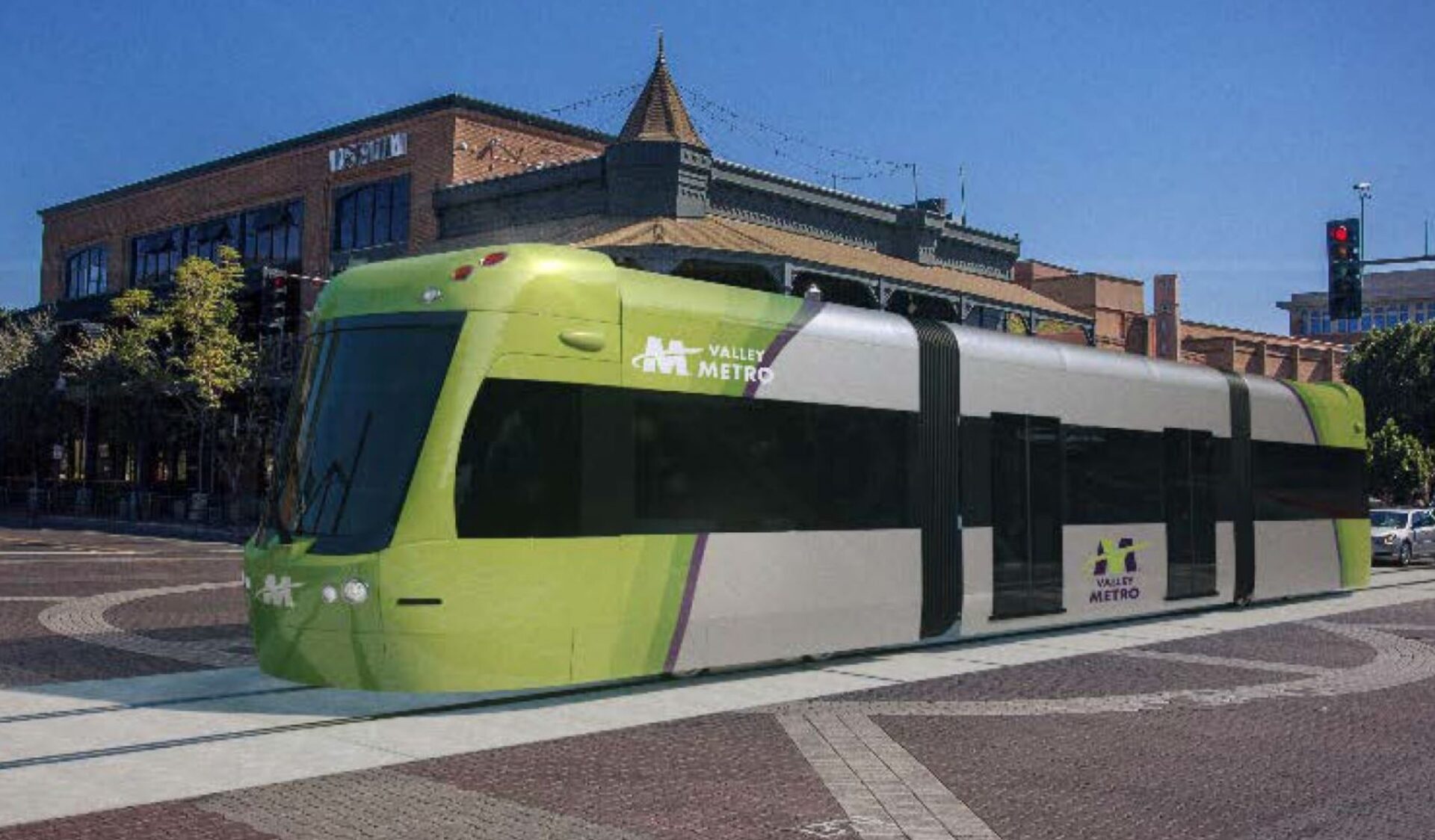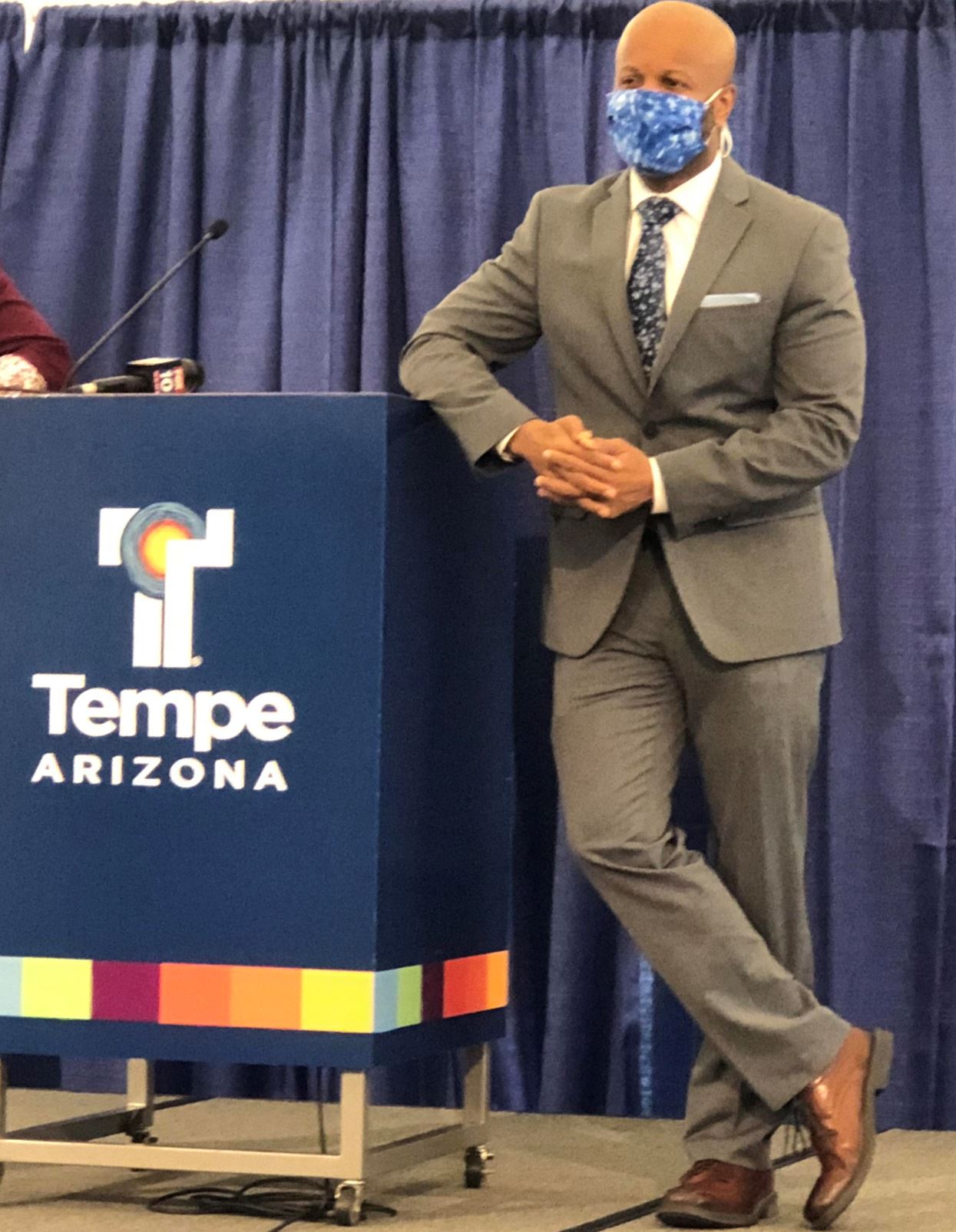
Tempe Mayor Corey Woods testified June 15 before the U.S. Senate Committee on Banking, Housing and Urban Affairs regarding the city’s infrastructure strategies, including innovative affordable housing and public-transit initiatives.
The hearing, 21st Century Communities: Local Leaders on the Infrastructure Needs Facing America’s States, Cities and Towns, included elected officials from across the country. Woods was introduced by Arizona Sen. Kyrsten Sinema, who spotlighted Tempe’s streetcar project as an example of “taking good locally-driven ideas and bringing them to life.”
Woods’ wide-ranging testimony touched on the city’s need for affordable housing, efforts to address homelessness, public-transit initiatives, sustainable-growth strategies and vital public-private partnerships. Woods also noted the city’s proactive financial response to the COVID-19 pandemic and recovery plans.
In addition, Woods spoke to the critical need for Congress to send more of Tempe’s federal tax dollars back to the city.
“We need continued and increased federal dollars to supplement our local investments in affordable housing, public transit, infrastructure and programs to provide relief to the homeless, those at risk of eviction and other at-risk groups as our economy recovers and local revenues get back on track,” Woods said.
____________________
TEXT OF TEMPE MAYOR COREY WOODS’ ADDRESS TO THE U.S. SENATE
Thank you for inviting me to be here today to speak with you about the housing and transportation infrastructure needs of America’s cities.
I am the mayor of Tempe, Arizona. You may not have heard as much about our city as our neighbors in the Maricopa County urban area, such as Phoenix and Scottsdale, but we are a thriving and innovative city. The 2020 Census will likely say that about 200,000 residents live within our borders. However, due to many businesses that call Tempe home, including the main campus of Arizona State University, we have a daytime population that is 70 percent greater than our Census population. We are a land-locked community, so we only have the option to build up as we continue to grow in size. With our focus on sustainable development, density and public transportation are central to our city’s long-term planning.
The median income of Tempe residents is about $58,000, a bit lower than the national average of $62,800. But the average cost of a home is more than $270,000, nearly 25 higher than the national average. In Tempe, this disparity between income and housing costs results in 42 percent of renters and 24 percent of homeowners being considered cost-burdened, which HUD defines as when a household pays more than 30 percent of their annual gross income on housing expenses.
In addition to a dire need for more affordable housing for middle-income workers, we also have struggled with addressing the housing needs of individuals experiencing homelessness. From 2015 to 2020, Tempe experienced an increase of over 900 percent in our unsheltered population.
Federal programs, such as Community Development Block Grants, HOME Investment Partnership Programs and Emergency Solutions Grant funding, have become essential components in delivering housing options to our most-vulnerable populations.

In 2016, Valor on Eighth, a 50-unit affordable-housing development that serves veterans and their families, opened to our community. This project used CDBG to acquire the land and HOME funds assisted with the construction of the facility. Low Income Housing Tax Credits (LIHTC) were utilized to finance the development while Project Based Vouchers in the facility allows for long-term affordability to be financially viable for its residents.
Just last week, I was at the construction site of the nation’s first 3D printed home. The city of Tempe transferred the property, originally purchased through CDBG funds, to Habitat for Humanity for construction of a total of 16 homes. This 3D-printed home offers an innovative model for the future of homeownership with a scalable, cost-effective solution and the federal government has a part in this success story.
Our city has invested heavily in affordable-housing initiatives. Through our Hometown for All initiative, we negotiate voluntary contributions from developers to our affordable-housing fund and we dedicate an amount equal to half of all permitting fees to these efforts. Since January of this year, this program has raised nearly $4.5 million.
Our City Council recently approved investing $1.2 million for the purposes of conducting environmental and archaeological assessments on city-owned land for the eventual development of 325 affordable rental-housing units and 50 affordable homeownership units. We are currently waiting for the developer to receive approval for Low Income Housing Tax Credits in order to get the project started.
Unfortunately, even with the city’s own investments, private partnerships and creative use of federal programs, we do not come close to meeting the needs of our cost-burdened residents nor addressing our extraordinary increase in unsheltered individuals. Tempe has benefited greatly from a 55 percent increase in allocations of CDBG, HOME and ESG over the last five years, and this upward trajectory of federal support is critical for us to continue our collaboration with our private and non-profit partners.
We simply cannot begin to meet the housing needs of our residents without increased federal support.
Public transportation is the other key to our sustainable-growth strategy. Many of Tempe’s future affordable-housing projects will be strategically located along the existing, metro-area light-rail system.
This regional train creates a travel corridor between central Phoenix and Mesa, the third-largest city in the state, with downtown Tempe and the ASU campus at the center of the regional light-rail system.
We have been fortunate to have broad support from our business community for a proposed expansion of this system, known as the Tempe Streetcar program. Businesses located along the streetcar corridor have instituted voluntary self-assessments to contribute to the project’s funding needs. Recently, the federal government, through the Federal Transit Administration, approved additional funding for the streetcar project and we are grateful for that investment.
Mesa, our neighboring municipality, and home to the Chicago Cubs spring-training facility, has partnered with us to explore the feasibility in expanding the streetcar from downtown Tempe into the city of Mesa. This expansion would span the public-transportation corridor through downtown Tempe, ASU’s upcoming 355-acre innovation corridor and a 1.3-million-square-foot open-air shopping development to the Cubs’ stadium, all the while linking industrial zones and creating opportunity for future affordable-housing development.
Just Friday, our City Council held a joint meeting with the boards of the Tempe Chamber of Commerce, Tempe Tourism Office and other local business leaders. We work very closely with our private-sector partners to plan Tempe’s future through thoughtful development that includes affordable housing and public transportation to ensure financial stability and access to economic opportunity for Tempe residents.
We invest a significant amount of Tempe tax dollars into these efforts and are committed to expanding these community resources. We are hopeful for an increased investment from the federal government so they can become an even bigger partner in the process of planning for Tempe’s future.
I would be remiss if I didn’t note that the city itself is managing through challenging financial times.
The city’s hotel-transaction privilege-tax revenues are down over 50 percent January 2021 as compared to January 2020, reflecting the steep decline in travel and tourism to our region. Similarly, tax revenue derived from restaurants/bars and amusements is down over 20 and 60 percent, respectively, over the same time period.
The loss of special events, ASU attendance, workers coming into the high-rises downtown, conferences and spring training has meant that the city has fewer resources to provide services while our residents and businesses are experiencing more needs.
To that end, we have been proactive in enacting cost-cutting measures for the city, and federal aid has played an important part in helping to maintain services while offering relief programs for our residents and businesses. Increased investments in infrastructure would provide the city with an important tool to address the negative economic impacts of COVID-19 and continue to develop our community with a sustainable and smart approach.
We need continued and increased federal dollars to supplement our local investments in affordable housing, public transit, infrastructure and programs to provide relief to the homeless, those at risk of eviction and other at-risk groups as our economy recovers and local revenues get back on track.
I am so grateful for the time you have allowed me to speak to you about Tempe’s perspective. I feel fortunate to do what I do every day. I look forward to answering any questions you might have.

